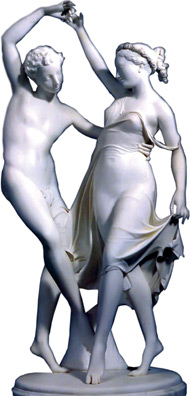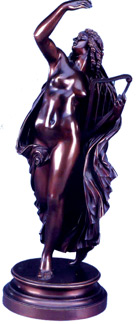The sculpture romantics
by Gwen Herat
France has produced the best sculpture romantics followed closely by
the Italians from the early 19th century. Sculpture is a mainstay in
their art world with their spectacular painters equally elated in the
same genre. One cannot pick as to who is the best of the lot but
sculptor Auguste Rodin of France leads the bandwagon.
|

The marble sculpture in pristine white of Flora and Zephyr
has been immortalised by critics and art lovers the moment
it was on display. At a staggering height of 170 cm it
became more famous than its sculptor, Giovanni Maria Benzoni. |
Rodin was as inexhaustible as one could have imagined with a passion
to explore an endless drama of high passion to the tenderness of
enduring love. His work was that of a poet, a great poet of emotions and
language.
His hands moulded bronze into sexuality and eroticism but they were
so highly artistic that only a handful noticed the sexualism he was
famous for. He was not afraid of the nudes so he passionately moulded
them. He represented the tragic love story of Paolo and Francesca as
well as Dante’ s Inferno.
His best sculpture is External Spring that created the illusion that
they are almost dancing together in their passion. How he did such an
overwhelming bronse moulding remains a mystery.
This was better known as Printemps Eternelle done in rich dark bronze
and brown patination and stands 66cm in height. Rodin who had a passion
for movement, concentrated only on figures and large animals and this
particular bronze miracle hangs in the Tate Gallery, London.
Finest sculptors
James Pradier (1790 -1852) was of French origin but born in Geneva,
he was regarded as one of the finest sculptors of the first half of the
19th century. He and his two brothers were trained as sculptors. A
leading figure from the Napolean's Superintendent of Arts, Dominique
Vivant Denon took him over to Paris and sponsored him at the Ecole des
Beaux Arts.
Winning the Prix Rome in 1813 was the gateway to his future success
and it was his major success. As he gained popularity, Pradier was
commissioned to exhibit his works by the government which resulted both
King Louise Phillip and the public being his ardent customers. However,
with time, he was more recognised for his statuettes and established
himself as one of the greatest in this form of art.
Sopho was his triumph moulded in 1848 in Bronze and silver along with
gilt.
Sopho who was a Greek poet so he attracted Pradier to her attributes
that he with no hesitation adorned this muse with a lyre and a poet's
scroll which he placed on the pillar at her side. The model for this
work was Loiuse Colet who was a poet herself and the mistress of Gustave
Flaubert.
Pradier was so fascinated with Sopho that he used her as inspiration
on more than three occasions and they are housed at the Angers Museum,
Osborne Museum and Louvre, Paris.
Giovanni Maria Benzoni (1809-1873) was born in Italy to a humble
family. He was blessed from the beginning having the good fortune of
studying under experts from his childood and later in Rome and the
Academia di San Luca specialising in classical and religious pieces
along with architectural scultures.
Benzoni exhibited at the Great Exhibition of 1851 in London which
helped him boost his reputation in England enormously. He was a sculptor
who opted to work at home on marble though at the beginning he
experimented with plaster. While in Rome, he was the recipient of huge
commissions from around the world.
The glorious and spectacular Flora and Zephyr Dancing was the
ultimate in marble with nothing left for imagination or addition. So
much so, his art work of this marble wonder was hailed as exemplary of
the contemporary School of Italian Romance which very few sculptors
acquired this acknowledgement.
Marble
Flora and Zephyr was carved out of one piece of Carrara marble,
balancing beautifully on the same medium. It was magnificent and
life-size, glowing in white infinitely. The Italian sculptors are well
known to give flesh to marble in exquisite softness and delicacy and
create marble into likeness of life.
|

French sculptor James Pradier's SOPHO done in 1848 at a
height of 45cm in bronze, silvered and gilt was a marvel
that established him instantly
with art lovers as well as with King Louise Phillepe who
thereafter commissioned him for many sculptures |
Benzoni was no different as he threw gossamer drapery that marble
appeared almost to breathe with life. People who saw the figures went
frenzy and there was always excitement in the air even if two people
gathered around this marble wonder.
There is a beautiful story behind marble-eternity, how Flora and
Zephyr became lovers. The legend has it that the beautiful Flora was
seen by Zephyr during one of his travels as god of the western wind and
fell instantly and deeply in love with her and carried her away and
married her.
He made his young bride the goddess of all flowers and blossoms upon
trees to demonstrate his eternal love for her and this immortalised her
beauty for ever. The goddess in return fed him with honey enjoyed only
by mortals.
Benzoni became famous for his allegorical subjects some of which
confirmed close to neo-classical style and among his styles are in
public collections that include La Galleria d'Arts Moderna in Milan, the
Museum of Fine Arts of Montral and the Art Gallery of Melbourne.
Spiritual art
Benzoni who was in great demand for spiritual art, had many of his
sculptures prominently placed in churches and places of worship. One of
such outstanding sculptures was the bas-relief of the Virgin Mary
moulded in 1857 and placed in Rome's Piazza Mignanelli. Benzoni's Museum
Collections are found in.
La Galleria d'Arts Moderna, Milan of statues representing the Four
Seasons.
Museum of fine Arts of Montral of Cupid and Insidious Love
Art Gallery of Melbourne of busts of the Four Seasons, Euterpe.
La Bibilio di Bergamo of Marble group representing the group of peace
with the genius of arts and science in 1844.
|

